 |
| Certificate in National Preparedness and Homeland Security |
| Certificate Philosophy |
| |
|
| |
| Preamble |
| |
| Creativity. |
|
| |
| This section provides the student with the administrative information necessary to survive this course and the certificate program. |
| |
|
| |
| Reading: |
Emergency Management Core Competencies, Daryl Spiewak, FEMA
Meeting Educational Challenges in Homeland Security and Emergency Management, Donald A. Donahue Jr., Stephen O. Cunnion, Ken Sochats and Carey D. Balaban, Journal of Homeland Security, February, 2010
Principles of Emergency Management, FEMA’s Emergency Management Institute, September 11, 2007
|
|
| |
|
| |
| Outline |
|
| |
|
| |
| Introduction |
The Homeland
Security Act of 2002 charged the newly formed Department of Homeland Security with "planning for building the emergency management
profession to prepare effectively for, mitigate against,
respond to, and recover from any hazard." All advanced profeessions are built upon a foundation that is informed by the sciences, arts and humanities. Medicine, for example, draws its concepts and practices from biology, chemistry, physics, mathematics, psychology, sociology, the humanities and many other disciplines.
Our work at the Center for National Preparedness at the University of Pittsburgh is dedicated to identify, and relate the same kinds of solid and rigorous underpinnings to the profession of National Preparedness and Homeland Security. |
| |
| Definition: | National Preparedness: A multidisciplinary, continuous and evolving effort to ensure coordinated, effective and efficient incident response at the federal, state, local and tribal level.
Source: Center for National Preparedness, University of Pittsburgh
|
|
| |
| Definition: | Homeland Security: A concerted national effort to ensure a homeland that is safe, secure, and resilient against terrorism and other hazards where American interests, aspirations, and ways of life can thrive.
Source: 2010 Quadrennial Homeland Security Review (DHS)
|
|
| |
| The NPHS Top Level Model |
The matrix below depicts and relates two universal aspects of homeland security and emergency management. The first of these, the "Fundamental Concepts", shown on the vertical axis, relates ideas that apply to all emergencies: the all hazards approach, situational awareness, common operating picture, risk management and lesson learned. The second aspect, which also applies to all emergencies, is the emergency management phases: preparedness, response, recovery and mitigation, is shown on the depth axis.
Our "Scientific Approach", shown across the horizontal axis, consists of four methodological constructs that can be used to empower each of the concepts and phases and systematically map the concepts onto the phases.
The reader should be cautioned in interpreting the model. While the model has much appeal and value in simplifying and communicating these complex relationships, each label on the model is really a complex entity and not mutually exclusive as implied in the model.
We will elaborate on the model throughout our courses. One should note that the "Scientific Approach" is embodied in the model itself i.e. It is evidence based; It is analytical; It is a visualization and it employs the systems of systems concept.
|
| |
| The NPHS Model |
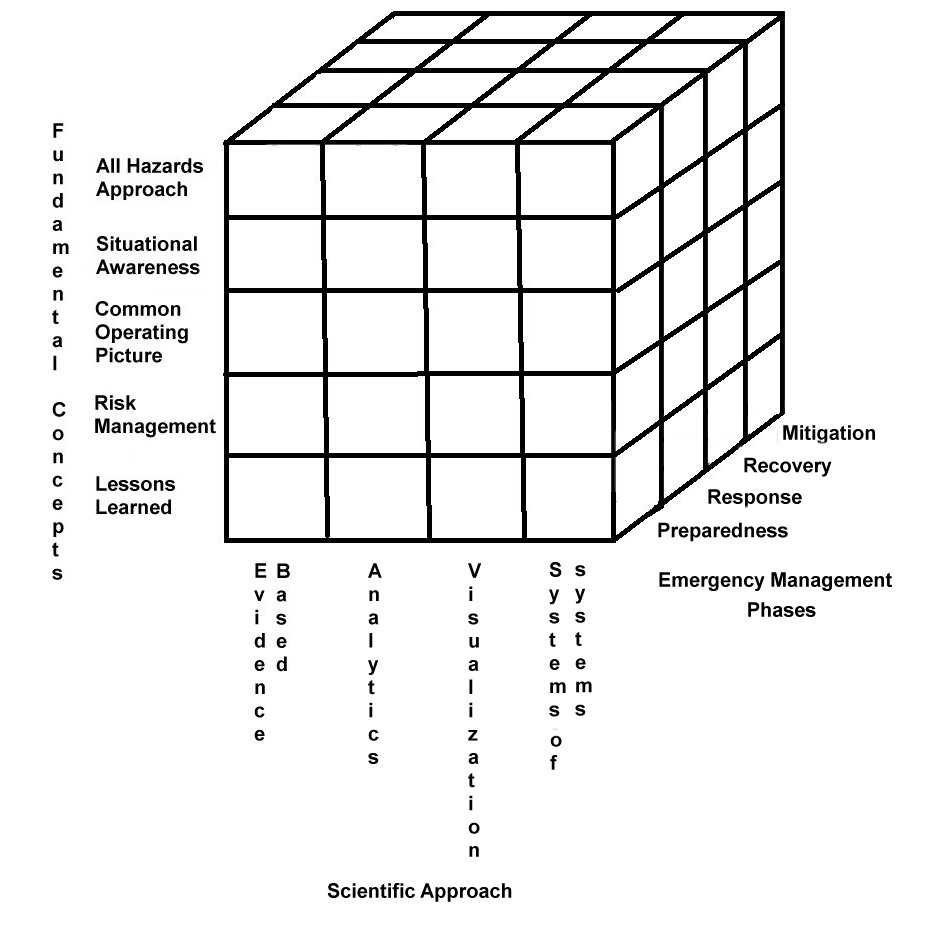 |
| |
| Emergency Management Phases |
| Definition: |
Emergency Management: An ongoing process to prevent, mitigate, prepare for, respond to, and recover from an incident that threatens life, property, operations, or the environment.
Source: NFPA 1600, 2007. |
|
| |
| FEMA portrays Emergency Management as a cyclic activity as shown in the diagram to the right. Unfortunately, this is an artifact of having to render the process on a two-dimensional display medium. It is really more appropriate to visualize the process as an upward spiral. If executed correctly, each cycle of the process from preparedness through response, recovery and mitigation should result in a higher level of preparedness. | 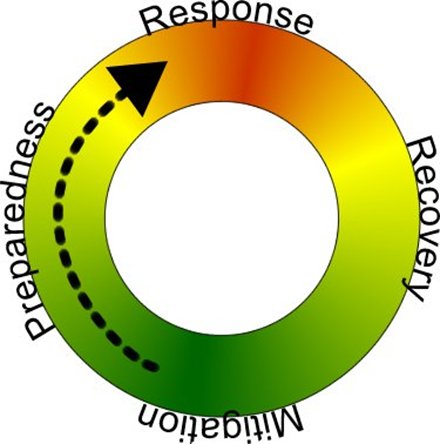
Emergency Management Cycle |
|
| |
| Definition: |
Preparedness: The existence of plans, procedures, policies, training, and equipment necessary at the Federal, State, and local level to maximize the ability to prevent, respond to, and recover from major events. The term ‘readiness’ is used interchangeably with preparedness.
Source: White House, HSPD-8. |
|
| |
| Definition: |
Response: Those activities and programs designed to address the immediate and short-term effects of the onset of an emergency or disaster.
Source: FEMA, Federal Response Plan, 1992. |
|
| |
| Definition: |
Recovery: Activities and programs designed to return conditions to a level that is acceptable to the entity.
Source: NFPA 1600, 2007. |
|
| |
| Definition: |
Mitigation: Those activities designed to alleviate the effects of a major disaster or emergency or long-term activities to minimize the potentially adverse effects of future disaster in affected areas.
Source: FEMA, Definitions of Terms, 1990. |
|
| |
| Fundamental Emergency Managemeent Concepts |
| |
May 23rd, 2010
US Coast Guard Admiral Thad Allen
On the Gulf Oil Spill
"They have the eyes and ears that are down there.
They are necessarily the modality by which this
is going to get solved," Allen said on CNN's
"State of the Union" program. "Our responsibility
is to conduct proper oversight to make sure they do that."
|
| |
| Definition: | All-Hazards: The spectrum of all types of hazards including accidents, technological events, natural disasters, terrorist attacks, warfare, and chemical, biological including pandemic influenza, radiological, nuclear, or explosive events.
Source: DHS, Federal Continuity Directive 1, 2007.
|
|
| |
| Definition: | Situational Awareness: The ability to identify, process and comprehend the critical elements of information about an incident.
Source: FEMA Glossary |
|
| |
| Definition: | Common Operating Picture: A continuously updated overview of an incident compiled throughout an incident's life cycle from data shared between integrated systems for communication, information management, and intelligence and information sharing. The common operating picture allows incident managers at all levels to make effective, consistent, and timely decisions. The common operating picture also helps ensure consistency at all levels of incident management across jurisdictions, as well as between various governmental jurisdictions and private-sector and nongovernmental entities that are engaged.
Source: FEMA National Incident Management System www.fema.gov/emergency/nims/Glossary.shtm
|
|
| |
| Definition: | Risk Management: The process of identifying, controlling, and minimizing the impact of events whose consequences are or may be unknown, or events that are themselves fraught with uncertainty.
Source: DHS, FCD 1, November 2007, P-9 |
|
| |
| Definition: | Lessons Learned: Knowledge gained through operational experience (actual events or exercises) that improve performance of others in the same discipline.
Source: FEMA, NIMS Compliance Metrics Terms of Reference, October 23, 2006, p. 6 |
|
| |
| The Scientific Approach |
| |
| Definition: | Evidence Based: Any concept or strategy that is derived from or informed by objective evidence.
Source: Glossary of Educational Reform, http://edglossary.org/evidence-based/ |
|
| |
| Definition: | Analytics: Mathematics, operations research, and statistics to drive better business decisions.
Source: Analytics Magazine (INFORMS), http://www.analytics-magazine.org/ |
|
| |
| Definition: | Visualization: The science of representing data, concepts, relationships and other artifacts by visual forms (e.g. diagrams, charts, graphs, maps, etc.) that are effectively and efficiently understood by humans.
Source:Center for National Preparedness, University of Pittsburgh. |
|
| |
| Definition: | Systems of Systems (SoS): A set or arrangement of systems that results when independent and useful systems are integrated into a larger system that delivers unique capabilities.
Source: Department of Defense (DoD), 2004, Defense Acquisition Guidebook Ch. 4 “System of Systems Engineering," Washington, DC: Pentagon, October 14. |
|
| |
|
| |
| Principles of Emergency Management |
| |
| Comprehensive |
emergency managers consider and
take into account all hazards, all phases, all
stakeholders and
all impacts relevant to disasters.
|
|
Progressive |
emergency managers anticipate future
disasters and take preventive and preparatory measures to
build disaster-resistant and disaster-resilient communities.
|
|
Risk-driven |
emergency managers use sound risk management principles (hazard identification, risk analysis,
and impact analysis) in assigning priorities and resources.
|
|
Integrated |
emergency managers ensure unity of effort among all levels of government and all elements
of a community.
|
|
Collaborative |
emergency managers create and sustain broad and sincere relationships among individuals and
organizations
to encourage trust, advocate a team atmosphere, build consensus,
and
facilitate communication.
|
|
Coordinated |
emergency managers synchronize the activities of all relevant stakeholders to achieve a
common purpose.
|
|
Flexible |
emergency managers use creative and innovative approaches in solving disaster challenges.
|
|
Professional |
emergency managers value a science and knowledge-based approach based on
education, training, experience, ethical practice, public stewardship and continuous improvement.
|
|
| |
| Definition: |
All-Hazards: The spectrum of all types of hazards including accidents, technological events, natural disasters, terrorist attacks, warfare, and chemical, biological including pandemic influenza, radiological, nuclear, or explosive events.
Source: DHS, Fed. Cont. Direct. 1, 2007. |
|
| |
|
| |
| Emergency Education and Training |
| |
| Group | Content |
| First Responders |
First Aid, Hazardous Materials Handling, etc.
|
| Emergency Managers |
Management Principles (Plan, Organize, Coordinate, Control)
|
| Policy Makers |
Laws, Protocols
|
Researchers and Decision Makers
|
Base Principles, Design, Analysis
|
|
| |
|
| |
| Core Competencies |
| |
|
Emergency Managers | Academics |
1. Planning
2. Hazard ID, Risk Assessment, Impact Analysis
3. Direction, control and coordination
4. Laws and authorities
5. Exercise evaluations, corrective actions
6. Communication and warnings
7. Hazard mitigation
8. Resource management
9. COOP/COG
10. Mutual Aid
|
1. Critical thinking
2. Verbal communications
3. Emergency and disaster management
4. Legal
5. Written communication
6. Management
7. Leadership
8. Exercises
9. Financial Management
10. Human Behavior
| |
|
| |
| |
|
| |
| Certificate Approach |
| |
- Evidence Based
- Systems of Systems
- Analysis and Modeling
- Visualization
|
| |
Evidence Based
- Evidence is a key provider of situation awareness
- Situation Awareness: A decision maker’s state formed by the information that he/she has about a situation,
his/her awareness of alternative futures and options and his/her ability to act
- Evidence
- Experience
- Expertise/Reasoning
- Personality
- Example – Forest Fire
|
| |
Evidence Factors
- Quantity
- Little/None
- Overwhelming - Information Overload
- Actionable
- Example - H1N1/ILI
- Confirmatory
- Quality
- Relevance
- Timeliness
- Precision
- Correctness
- Source
- Trusted
- Official
- Automatic - Sensor
- Database
- Anecdotal
- Trained Observer
|
| |
Systems of Systems
- System
- Purposeful Entity
- Organized
- System Components
- Inputs
- Outputs
- Processes
- Control
- Subsystems
- Environment
|
| |
Systems of Systems Issues
- Dependence
- Inter/Codependence
- Compatibility - Interfaces
- Collocation
|
| |
| Definition: |
Systems of Systems (SoS): a set or arrangement of systems that results when independent and useful systems are integrated into a larger system that delivers unique capabilities.
Source: Department of Defense (DoD), 2004, Defense Acquisition Guidebook Ch. 4 “System of Systems Engineering," Washington, DC: Pentagon, October 14. |
|
| |
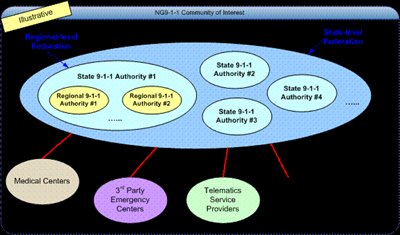 |
| |
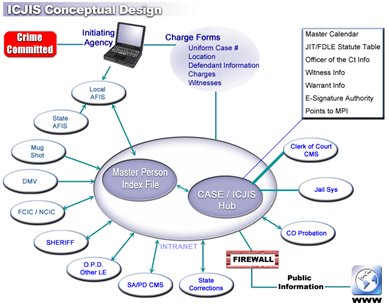 |
| |
Analysis and Modeling
- Analysis Issues
- Components
- Objects
- Actors
- Relationships
- Structure
- Processes
- Representation
- Modeling Issues
- Causes/Effects
- Incremental
- Complexity
- Assumptions
- Formality
- Bounding/Optimality
- Examples
|
| |
| |
| Modeling Pandemics |
| |
| At a meeting on emergency preparedness in 2005, Major General Barbish (US Army, ret.) and I discussed the impact and likelihood of a pandemic like the 1918 (H1N1 virus avian) flu. Dr. Barbish was a senior advisor to the Department of Defense for chem bio defense. Our interest spanned the spectrum from man-made to natural biological events. Our strategy was to use evidence from the 1918 pandemic to build a model of the spread of the pandemic and extrapolate that model to the current US environment. |
| |
| The 1918 Pandemic |
| |
It is not known where the pandemic originated but it spread worldwide during 1918 - 1919. It was identified in returning American World War I veterans in early 1918. Data on the impact and location of the pandemic is very sketchy. Even within the united states, there was no uniform and standardized reporting of illness. The Centers for Disease Control and Prvention (CDC) was not to be established until over thirty years later. The data that was used in our model was extracted from data and estimates provided by the CDC. The CDC estimates the number of deaths worldwide to be in excess of 50 million and approximates US deaths at 675,000. While this data was synthesized from reports amd estimates, it is the best evidence available.
The map below is one of a series of maps produced by the CDC showing the progress of the disease across the US. This map shows the state of infections between September 21 and 28, 1918. The map series shows the spread of the disease as soldiers arrive home from the War in Europe and return to their homes. Since the predominant mode of international travel in 1918 was via oceangoing ships, there is significant concentration of the disease around seaports with pockless concentration at locations inland. Eventually in 1919 the maps show the disease spreading to everywhere in the US. |
| |
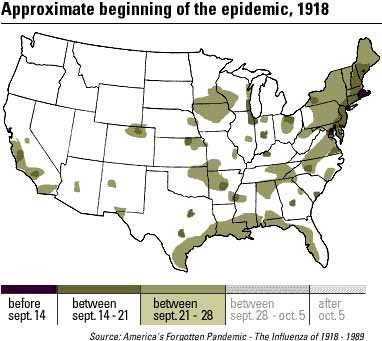 |
| |
| The map below is an earlier map in the CDC series. I am a railroad buff and immediately recognized the pattern of spread corresponding to rail depots in cities. Rail was the predominant mode of travel in the US at that time. The returning veterans got off their ships and took trains to the closest points to their homes. They also took with them the virus. The map has the major rail lines overlayed on the CDC data. |
| |
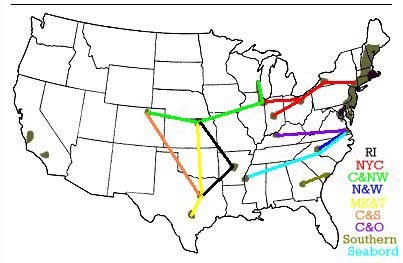 |
| |
Several observations can be made from this map. First is that the rail infrastructure in the US at that time provided a mechanism for transporting the disease. Note that different railroads were involved in different ways. Note that the early disease spread along the New York Central Railroad (New York City, Buffalo, Cleveland) and not along the Pennsylvania railroad (Philadelphia, Harrisburg, Pittsburgh, Columbus). This is probably due to the relative passenger traffic of the railroads.
Another important observations is the structure of the rail system in the midwest. The cities connected in the midwest are largely beef producing and transhipment locations. In the time beef was shipped by rail to the meat packing fecilities in Chicago for processing and shipment to large urban centers in the east. In effect the beef infrastructure relied heavily on the rail infrastructure, something called systems-of systems.
These factors may be an explanation for the "waves" of flu identified by some researchers.
|
| |
| The Pandemic Model |
| |
Extrapolating the 1918 pandemic model to today is rather straightforward. Large numbers of passengers returning from Europe would land at our modern points-of-entry, the airports. They would then get on a connecting flight or travel home by highway. The map below shows international airports (large airplane icons), regional airports (blue dots) and the modern interstate system (blue lines). Superimposed on this is a set of concentric circles showing where the passengers are at every two hours. The simulation was built using the flight schedules for the major airlines. Things like layovers are built into the simulation. As one can see, if it goes unchecked, in a very short time the pandemic covers most of the US.
This result is not too surprising. Our jets are many times faster than the trains of 1918. There are many international airports located well within the continental US. Our interstate highway system is as robust as the rail system and travel is at speeds comparable to rail speeds. |
| |
 |
| |
| |
| |
Visualization
- Human visual bandwidth highest of senses
- Displays can be content rich
- Multimedia
|
| |
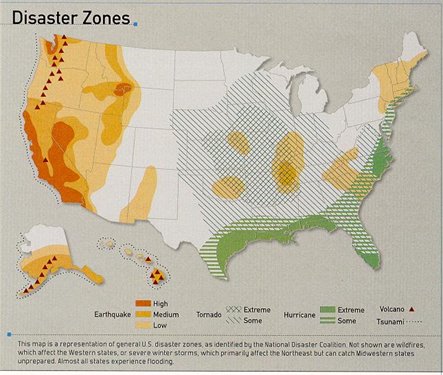 |
| |
|
| |
Certificate Program in National Preparedness and Homeland Security (NPHS)College of General Studies
University of Pittsburgh |
| |
| The Certificate Program in National Preparedness and Homeland Security (NPHS) is a post-baccalaureate certificate comprised of 18 credits of coursework. Four courses (12 credits) are required. Two elective courses (6 credits) may be selected from a wide range of pre-approved university and other offerings. A student may petition to have another relevant course approved for his or her program of study. In addition Internship and Independent Study courses are offered. |
| |
| Requied Courses |
| |
Course: NPHS 1510
Title: FEDERAL/INTERNATIONAL FRMWRK EMERGY PREP
Credits: 3 |
| |
Course: NPHS 1520
Title: STATE/LOCAL FRMWRK EMERGY PREP
Credits: 3 |
| |
Course: NPHS 1530
Title: ANALYSIS/DECISION TOOLS-EMR PREP
Credits: 3 |
| |
Course: NPHS 1540
Title: CAPSTONE
Credits: 3 |
| |
| Elective Courses |
| |
Course: NPHS 1900
Title: INTERNSHIP-NPHS
Credits: 3 |
| |
Course: NPHS 1901
Title: INDEPENDENT STUDY-NPHS
Credits: 3 |
| |
|
| |
| Copyright © 2011 - 2022 Ken Sochats |








